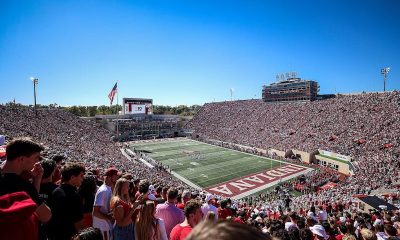NIL
Colleges Implement Student Fees to Fund Athlete Revenue-Sharing

Last Updated on July 7, 2025
The revenue-sharing era in college sports has arrived, and with it, there is a growing trend among colleges to incorporate student fees into their operations. The University of South Carolina’s board of trustees approved a $300 athletics fee for all undergraduate students starting during the 2025-26 academic year. This news comes one year after South Carolina’s rival, Clemson University, enacted a similar student fee of $150 per semester. The Associated Press reported that the cost intends to raise anywhere from $7 to $8 million for athletics during the 2025-26 school year.
According to a press release, South Carolina’s fee is “designed to continue student access to athletics events/ticket lottery, address increased event/program operating costs, and enhance the student experience across multiple USC sporting venues.” The cost will be in addition to the amount students pay for tickets, which is approximately $86 per semester. Furthermore, these funds will support areas such as health and safety, event staff, and facility upgrades.
Within the same period, the Florida University Board of Governors approved the use of up to $22.5 million by Florida universities from revenue sources, including student fees, to pay for college athletes as a result of the settlement of the House v. NCAA, where schools were approved to pay up to $20.5 million to their college athletes.
“If our Board of Governors did not take action to assist the universities in the short term, our universities would be at a competitive disadvantage,” said Chancellor of the State University System of Florida Ray Rodrigues.
Rodrigues, who supervises the Board of Governors, added that all of the state’s power five conference teams will take advantage of the $22.5 million. West Virginia University has also implemented a $125 Mountaineer Athletic Advantage Fee per student. The fee, like most of the ones above, is in place to help support the future of WVU athletics.
Student fees are just one of the many ways in which universities are using to fund athletic initiatives in the new revenue-sharing era of college athletics. Furthermore, these fees not only represent a new aspect of campus life for students but also a new way of life for universities, which must now prioritize paying their athletes.
NIL
President Trump appears to take jab at Michigan football while talking about NIL

ANN ARBOR, Mich. – The Michigan Wolverines football program has been in the news lately following the recent firing and arrest of former head coach Sherrone Moore.
Moore’s incident spread nationally, giving the University of Michigan unwanted press.
For some, the best time to kick a person is when they are down, as President Donald Trump appeared to take a jab at the football program while discussing NIL.
Trump strongly criticized name, image, and likeness (NIL) deals in college sports, calling the current state a “disaster.”
He criticized the large sums paid to college athletes, particularly in football, saying colleges cannot afford to pay quarterbacks millions of dollars straight out of high school.
“You can’t pay a quarterback $14 million to come out of high school. They don’t even know if he’s going to be a very good player,” Trump said.
The high school athlete Trump was allegedly talking about was true freshman quarterback Bryce Underwood.
When Michigan landed the Belleville native, it was reported that he would garner north of $10 million to don the maize and blue.
Trump described the NIL as “horrible for the Olympics” and “actually horrible for the players,” emphasizing that the financial model is unsustainable.
“They were training grounds for the Olympics,” Trump said. “A lot of these sports that were training so well would win gold medals because of it. Those sports don’t exist because they’re putting all their money into football.”
Trump continued: “The most successful colleges are losing money,” Trump said. “It’s a disaster for sports.”
He also warned that basketball and other sports are being affected as colleges funnel money into football.
“They will not be able to stop it,” Trump said. “If we give a guard $7 million, we’re going to win the national championship. But colleges cannot afford to pay those kinds of salaries.”
Trump suggested that a strong salary cap is necessary to prevent colleges from financially wiping themselves out.
“Something ought to be done. I’m willing to put the federal government behind it,” Trump said. “If it’s not done fast, you’re going to wipe out colleges, including ones that do well in football.”
Trump concluded by emphasizing the financial danger colleges face if the NIL system continues unchecked.
“Colleges cannot afford to play this game. It’s a very bad thing that’s happening,” Trump said.
Bryce Underwood
Underwood and the men in maize are gearing up for the Cheez-It Citrus Bowl, where they will take on the Texas Longhorns in Orlando, Florida, on New Year’s Eve at 3 p.m.
Michigan finished the regular season with a 9-3 record, but Underwood, who was named the fourth true freshman in program history to start at quarterback, struggled at times.
Underwood had 2,229 passing yards, nine touchdowns, and six interceptions during his first year as the starter.
He was expected to be the day-one starter since he flopped from LSU and committed to Michigan, but it was expected to be some growing pains as he got used to the college game.
Michigan relied on the rushing attack of Justice Haynes, Jordan Marshall, and Bryson Kuzdzal throughout the season.
But Underwood, who completed 179 of 293 passes, also used his legs, carrying the ball 74 times for 323 yards and five touchdowns.
He seemed to find a top target in fellow true freshman wide receiver Andrew Marsh, who broke out this season as well.
But with the new weapons coming in, in the class of 2026, alongside some transfer portal guys, Michigan, along with their new head coach, should take the next step next season.
Copyright 2025 by WDIV ClickOnDetroit – All rights reserved.
NIL
Oregon State Announces Termination of Blueprint Sports Deal

Oregon State University and NIL consulting firm Blueprint Sports have “mutually agreed” to terminate their partnership, two-and-a-half months after a Sportico report on the deal’s terms sparked a wave of backlash from Beavers fans. The effective date of the termination was Dec. 8.
In a statement Monday, an OSU spokesperson said Blueprint would retain a $280,000 management fee the school had already paid for 2025-26, but will cease making payments going forward. The school had previously agreed to pay management fees of $287,500 and $285,225 for the next two academic years.
Blueprint Sports, in turn, has agreed to transfer to the university all net proceeds it collected in its brief tenure serving as OSU’s NIL deal-sourcing facilitator, including 100% of net revenue from memberships and subscriptions it sold. That money will now be routed to the university’s revenue-sharing account, according to the university.
In response to a follow-up question from Sportico, an OSU spokesperson said gross proceeds of NIL funds “may be subject” to a 1.25% contract administration fee provided for in the agreement.
Blueprint CEO Rob Sine did not respond to a text message seeking comment.
The termination will also effectively dismantle the OSU-affiliated Dam Nation Collective, which Blueprint had paid six-figures to acquire as part of the broader arrangement. According to OSU, Dam Nation Collective no longer has any official affiliation with the university.
Monday’s announcement brings an end to one of the more fraught partnerships of the NIL era. Blueprint Sports, which had previously served as an operator and owner of dozens of NIL collectives, has sought to pivot in the post-House v. NCAA era by positioning itself as an on-the-ground consultant.
Sine, who previously worked as an executive at IMG, is attempting to implement a business model familiar in the college multimedia rights arena—where external consultancies establish operations within athletic departments.
In return for its services, Blueprint charged a fee designed to cover the cost of dedicated staffers, along with a share of the NIL revenue it helped generate or processed. The revenue-sharing aspect, first reported by Sportico, became the central point of dispute in Corvallis.
Under the agreement, Blueprint was slated to receive a fundraising bonus equal to the 75% of the NIL revenues it generated between $750,000 and $1.15 million. The school spokesperson confirmed that because the minimum threshold of $750,000 was not reached this year, Blueprint would not receive that bonus.
In May, Blueprint signed Maryland as its first consulting client. Sine later told Sportico the firm’s financial arrangements with the Terrapins were similar to those with Oregon State, although Maryland—at Blueprint’s beckoning—has declined to publicly disclose those details, even in response to open records requests.
Oregon State, which had no previous affiliation with Blueprint, became its second consulting client in August, facilitated in part by the prior connection between OSU executive deputy athletic director Brent Blaylock and the company.
Blaylock previously worked as senior associate athletic director at Arizona, whose primary football collective, Desert Takeover, is operated by Blueprint.
At Oregon State, Blaylock served as the university’s primary point of contact for the Blueprint partnership and, ultimately, became its fall guy, resigning from his post in late October. Even after leaving, he continued to attract scrutiny and suspicion about whether he stood to personally benefit from the arrangement. Last week, the university wrapped up an internal investigation—initiated after an OSU fan podcast raised concerns—into personal LLCs owned by Blaylock and their connection to the Blueprint partnership. The school concluded there was none.
Although sports journalist John Canzano reported in late October that Blueprint and Oregon State were parting ways, neither the school nor company publicly confirmed as much until this week. Last month, Sportico sent a records request to OSU seeking any termination agreements or other documents that would modify the original Blueprint deal; the university said it anticipated providing responsive documents by Wednesday.
While Oregon State now appears set to move forward without an in-house NIL consultant, it remains to be seen whether Blueprint will continue on the same path or pivot again. Last week, the company posted job openings in Texas for a “manager/director of fan engagement & experiences” and a “client services & operations manager,” though the listings did not specify any particular university.
NIL
How do College Football Playoff teams compare financially? The gap can be tens of millions

This year’s College Football Playoff reflects the adage that you get what you pay for.
The 12-team field includes the four teams with the largest football budgets, the nation’s two highest-paid coaches and three of the four highest-paid general managers. It also sets up a potential quarterfinal matchup where one head coach makes more than his competitor’s entire recent football budget.
A few standard financial disclaimers: Different programs run their numbers differently. Budgets change yearly, and some figures are murky or missing, especially regarding private schools and NIL. Even with those caveats, we can still get a broad sense of how the 12 CFP contenders stack up against one another financially.
The first-round Texas A&M-Miami game looks even bigger through this lens, doesn’t it?
Texas Tech’s figure is the lowest of the Power 4 teams here but about average in the Big 12; 11 of the conference’s members spent in the $30 million to $40 million range that year.
The gap between Alabama and Tulane is large, but maybe not this large. We’ll make our wonky explanation as brief as possible: We’re using the U.S. Department of Education database because it’s the only tool that includes every public and private school (except service academies). However, reporting lags behind, so the most complete numbers are from 2023-24. Alabama’s figures were exceptionally high that year, and Tulane’s figures were exceptionally low.
Fortunately, the Green Wave and Crimson Tide have both posted more recent federal reports. Alabama reported $78.5 million in expenses in 2024-25. Tulane reported $22.7 million, which was still behind South Florida ($33.4 million) in the American Conference.
Again, Tulane’s figure is abnormally low and ahead of only Kennesaw State ($8.3 million) nationally. But the Green Wave’s most recent report listed football revenue at $24 million. Ohio State’s football income is also much larger ($160.5 million in its latest report).
The No. 1 program was Texas at just north of $200 million. I’m sure that’ll make the Longhorns feel great knowing the Aggies are in the first round. Another rivalry aspect: Indiana ranked one spot below Purdue ($61.6 million).
Half the field ranked in the top 14 nationally in football revenue. That’s about the same as the numbers we ran last year, when six of the participants were in the top 11.
What CFP teams paid their coach
*Yes, we know Kiffin is no longer coaching the Rebels.
Source: USA Today’s coaching database for the 2025 season
Because Tulane is a private school, its coaching salaries are not public. But Jon Sumrall’s Green Wave salary is believed to be in the $3 million range. That would put him near the top of the Group of 5, somewhere between UNLV’s Dan Mullen ($3.5 million) and South Florida’s Alex Golesh ($2.5 million). Sumrall’s base salary at his new Florida job is $7.45 million.
Kiffin’s Ole Miss replacement, Pete Golding, is set to earn $6.8 million for his first year.
Of the nine coaches who earned more than $10 million this year, four made the CFP. The five who didn’t: USC’s Lincoln Riley, Clemson’s Dabo Swinney, Texas’ Steve Sarkisian, LSU’s Brian Kelly and North Carolina’s Bill Belichick. Curt Cignetti and Mike Elko will join that tier with the new contracts they landed this season. Cignetti’s salary almost doubled from last year ($4.25 million), but he still seems like a bargain.
Joey McGuire and Bob Chesney were also great deals. McGuire’s salary was 10th in the Big 12 and about half what Colorado paid Deion Sanders (just under $9 million). Chesney was second to last in the Sun Belt, ahead of only Louisiana-Monroe’s Bryant Vincent.
Apples-to-apples comparisons of general managers are trickier because of how quickly front offices are evolving, plus their different titles and strategies. But 13 programs pay their general managers at least $500,000, according to USA Today’s database. Five of them are in the Playoff: Ohio State, Oregon, Alabama, Oklahoma and Texas Tech.
What we know about how much they pay players
After schools could start legally paying players directly on July 1, The Athletic submitted public records requests for revenue-sharing budgets and payrolls to more than 70 public schools. Oklahoma and Ohio State are among those that still have not responded. Records in some places, like Georgia and Oregon, are shielded by state laws. Texas A&M’s denial also cited an exemption against releasing information that “would harm its interests by providing an advantage to a competitor … or in a particular ongoing competitive situation.”
We can, however, offer a few concrete numbers.
James Madison’s revenue-sharing budget is a little more than $1 million, according to its payroll data. That figure is split among 34 players (whose names were redacted). Two players are making $65,000, and four are making $7,500 each. Four men’s basketball players were set to make more than the highest-paid football player.
Texas Tech’s roster cost about $25 million, general manager James Blanchard told The Athletic in the preseason. About $12 million went to 21 transfers. An internal document obtained through a public records request provides more insight. From July 2024 through May 2025, the Red Raiders’ NIL budget in football was $13.5 million. That’s up from $3.4 million the year before.
The Sooners’ NIL entity, 1Oklahoma, paid players $32 million in the 2024-25 fiscal year, according to OU board of regents documents from September. That figure isn’t broken down by sport.
Our best look at Tulane is from 2023. That year, the Fear the Wave Collective Group reported almost $955,000 in revenue on its federal tax returns. Its expenses were $774,000 but not itemized much beyond that.
Because most numbers aren’t public, we asked a pair of NIL agents to rank the teams based on player compensation. Both put Texas Tech, Miami and Texas A&M in their top four. Georgia and Alabama were in the bottom half of the bracket, and the last three were the same (in order): Oklahoma, Tulane and JMU.
An underDukes story
The $93 million revenue gap between first-round foes Oregon and JMU isn’t only the largest in this field. By our math, it’s the biggest disparity of any CFP matchup so far, including the four-team era.
Here’s a stunning way to contextualize it: What JMU paid its head coach and entire roster (just under $1.9 million) is less than Oregon paid its defensive coordinator, Tosh Lupoi ($2 million). Ducks head coach Dan Lanning’s $10.4 million salary is three times the Dukes’ annual football operating expenses ($3.2 million).
James Madison’s budget is competitive in the Sun Belt, but it’s not No. 1. That was Coastal Carolina ($17.3 million in football revenue).
NIL
Transfer QB Sam Leavitt pursued by four elite college football programs

Former Arizona State quarterback Sam Leavitt is no longer the only elite quarterback in the transfer portal. Leavitt made his intentions to leave ASU clear a few weeks ago, but over Sunday and Monday, several more top QBs have announced their intention to transfer. Now, several programs are already locking horns on the recruiting trail over these guys.
Cincinnati’s Brendan Sorsby, Florida’s DJ Lagway, and Nebraska’s Dylan Raiola all became major names to hit the transfer portal at the quarterback position over the start of this week. And as soon as news broke that those QBs would enter the portal, lists of potential desintations already came up. But after a quiet few days on the Sam Leavitt front, a new list of high-profile suitors was reported for the ASU star.
On3 posted on Monday afternoon that Pete Nakos had heard of the following list of schools as connected to Leavitt: “Among the early schools On3 is hearing about in his recruitment include Oregon, Indiana, Miami and LSU, sources tell On3,” Nakos wrote.
What’s interesting is that Leavitt’s fellow transfer quarterbacks shared somewhat similar lists of reported interest. Lagway had Miami and LSU on his list, Sorsby once attended Indiana and also had the Hoosiers on his first reported shortlist. Meanwhile, Dylan Raiola’s camp has indicated that he would love an Oregon offer.
So, already, there is some crossover between these quarterbacks — which schools are pursuing them and which schools they’re showing their own interest in. Buckle up, folks, because we are just getting started with the transfer portal and particularly the QB class.
Background, stats for Sam Leavitt

As for Leavitt, though, someone will be getting a tough and battle-tested leader more than capable at the power conference level. After all, Sam Leavitt did lead Arizona State to a Big 12 championship as a redshirt freshman in 2024 despite the Sun Devils being picked last place in the conference in the preseason media guide. 2025 featured a less successful follow-up season to ’24 for ASU while Leavitt unfortunately suffered a Lisfranc injury that took him out for the remainder of the season.
In 2024, Leavitt put up ,ore than 3,000 combined passing and rushing yards with 29 total touchdowns, leading Arizona State to an 11-3 record and competitive loss against Texas in a second-round loss after receiving a first round bye in the first-ever 12-team College Football Playoff. In seven starts this season, Sam Leavitt threw for 1,600 yards and 10 touchdowns.
Miami obviously had success with Carson Beck this year and is heading to the College Football Playoff. Indiana speaks for itself after the work it did in 2024 and 2025 and especially on the heels of a Fernando Mendoza Heisman. Plus, LSU offers Lane Kiffin and elite recruiting pipelines with skill players, while Oregon has perhaps the most impressive four-year run of quarterback play to boast. Those are some ELITE options for rising redshirt junior Sam Leavitt.
More on College Football HQ
NIL
NIL shaping futures of Virginia Tech athletes

BLACKSBURG, Va. (WDBJ) – Name, Image and Likeness, better known as NIL, has changed the college sports world since it was introduced in 2021.
But what is NIL?
In short, players can earn money from endorsements, social media, and other avenues while playing their sport.
Those players can use that money however they like, anything from paying for food outside the school cafeteria to setting up their financial futures.
These are things that until 2021 could cost a player his college eligibility and shut down an entire football program.
“I know a lot of guys working on retirement accounts right now, which is, it’s fantastic that before you even step out into the real world, if that’s where you go, you already have all this big of a foundation set up for you to move forward with life.”
Kyle Lowe began his journey at Virginia Tech in 2020 as a preferred walk on and worked his way into a scholarship, even earning the chance to wear honorary number 25 for the Hokies.
With the hard work came NIL opportunities, opportunities that would shape his future after football.
“I started out coming here not knowing what to do between a checking account and a savings account, and now I’m looking at different types of options investing wise,” He said. “I’ve had the opportunities to start investing in other aspects like mutual funds, all of these options.”
NIL did more then prepare him financially, it revealed his passion for teaching other financial literacy, inspiring him to pursue a career as a financial advisor.
“I started talking to guys in the locker room about different aspects of investing, and it kind of made me realize that this is something I really enjoy doing,” Lowe said. “I love talking to people I’m close with about investment opportunities. I love to see guys succeed financially, and that’s all stemming from NIL.”
Copyright 2025 WDBJ. All rights reserved.
NIL
College football program loses 12 players to transfer portal after coaching change

The coaching carousel and NCAA transfer portal; where worlds collide.
A record number of coaching changes across the FBS has impacted the number of players searching for new homes this offseason. The portal was going to fill up regardless, but firings and hirings around the country have sped up the process, creating some surprises along the way.
The Big Ten has been at the forefront of some major coaching decisions. Four programs in the conference (Michigan, Michigan State, Penn State, UCLA) fired their head coaches. Another job opened after Iowa State’s Matt Campbell jumped into the opening at Penn State.
In the case of the Michigan State Spartans, the program has struggled to find stability since Mark Dantonio retired following the 2019 campaign.
The Spartans are onto their third head coach in the last five years, bringing in former Northwestern head coach Pat Fitzgerald to replace the struggling Jonathan Smith.
Since moving on from Smith in late November, 12 players have announced plans to transfer from the program, including a few key names. Check out the full list below, per On3’s transfer tracker.
12 Players (And Counting) From Michigan State To Enter Transfer Portal
|
Name |
Position |
Class |
|---|---|---|
|
Aidan Chiles |
QB |
Junior |
|
Makhi Frazier |
RB |
Sophomore |
|
Nick Marsh |
WR |
Sophomore |
|
Gavin Broscious |
OL |
RS Junior |
|
Tyler Gillison |
EDGE |
RS Junior |
|
Marcellius Pulliam |
LB |
Junior |
|
Darius Snow |
LB |
Sixth-Year Senior |
|
Semaj Bridgeman |
LB |
RS Sophomore |
|
Ade Willie |
CB |
Senior |
|
Jeremiah Hughes |
CB |
Junior |
|
Justin Denson Jr. |
S |
Sophomore |
|
Tracy Revels |
S |
RS Sophomore |
There are a few big losses to note for Michigan State, especially on the offensive side of the ball.
On Monday, junior quarterback Aidan Chiles became one of the latest players to depart from Michigan State. Chiles followed Smith from Oregon State and started for the majority of the last two seasons before losing his job late in 2025.
A two-time team captain, Chiles completed 192-of-323 passes for 2,415 yards with 13 touchdowns to 11 interceptions this season. He added 225 yards and 3 more scores on the ground.
Running back Makhi Frazier and wide receiver Nick Marsh are two other Spartans searching for a fresh start.
Frazier led the team in rushing this fall, accumulating 116 times for 520 yards and 2 touchdowns.
Marsh was the top pass-catcher on the Spartans, recording 59 catches for 662 yards and 6 touchdowns, earning honorable mention All-Big 10 honors. He’s totaled 1,311 yards and 9 scores in 23 games, meaning he should be a coveted option in the portal.
Fitzgerald will have his work cut out for him to rebuild Michigan State into a conference championship contender.
The Spartans have compiled a 31-37 overall record since 2020. 11 of those victories came in 2021, the only season in which Michigan State has finished with a winning record in that stretch.
Read more on College Football HQ
• College football OL with no sacks allowed enters NCAA transfer portal
• All-conference EDGE with 18 career sacks to enter college football transfer portal
• Paul Finebaum urges to cut specific programs from College Football Playoff
• Major college football program loses 15 players to transfer portal after 2025 season
-

 Rec Sports3 weeks ago
Rec Sports3 weeks agoFargo girl, 13, dies after collapsing during school basketball game – Grand Forks Herald
-

 Motorsports3 weeks ago
Motorsports3 weeks agoRedemption Means First Pro Stock World Championship for Dallas Glenn
-

 Motorsports2 weeks ago
Motorsports2 weeks agoJo Shimoda Undergoes Back Surgery
-

 NIL2 weeks ago
NIL2 weeks agoBowl Projections: ESPN predicts 12-team College Football Playoff bracket, full bowl slate after Week 14
-

 Rec Sports2 weeks ago
Rec Sports2 weeks agoHow this startup (and a KC sports icon) turned young players into card-carrying legends overnight
-

 Rec Sports2 weeks ago
Rec Sports2 weeks agoRobert “Bobby” Lewis Hardin, 56
-

 Motorsports6 days ago
Motorsports6 days agoSoundGear Named Entitlement Sponsor of Spears CARS Tour Southwest Opener
-

 Motorsports3 weeks ago
Motorsports3 weeks agoPohlman admits ‘there might be some spats’ as he pushes to get Kyle Busch winning again
-

 NIL3 weeks ago
NIL3 weeks agoIndiana’s rapid ascent and its impact across college football
-
Sports2 weeks ago
Wisconsin volleyball sweeps Minnesota with ease in ranked rivalry win






























